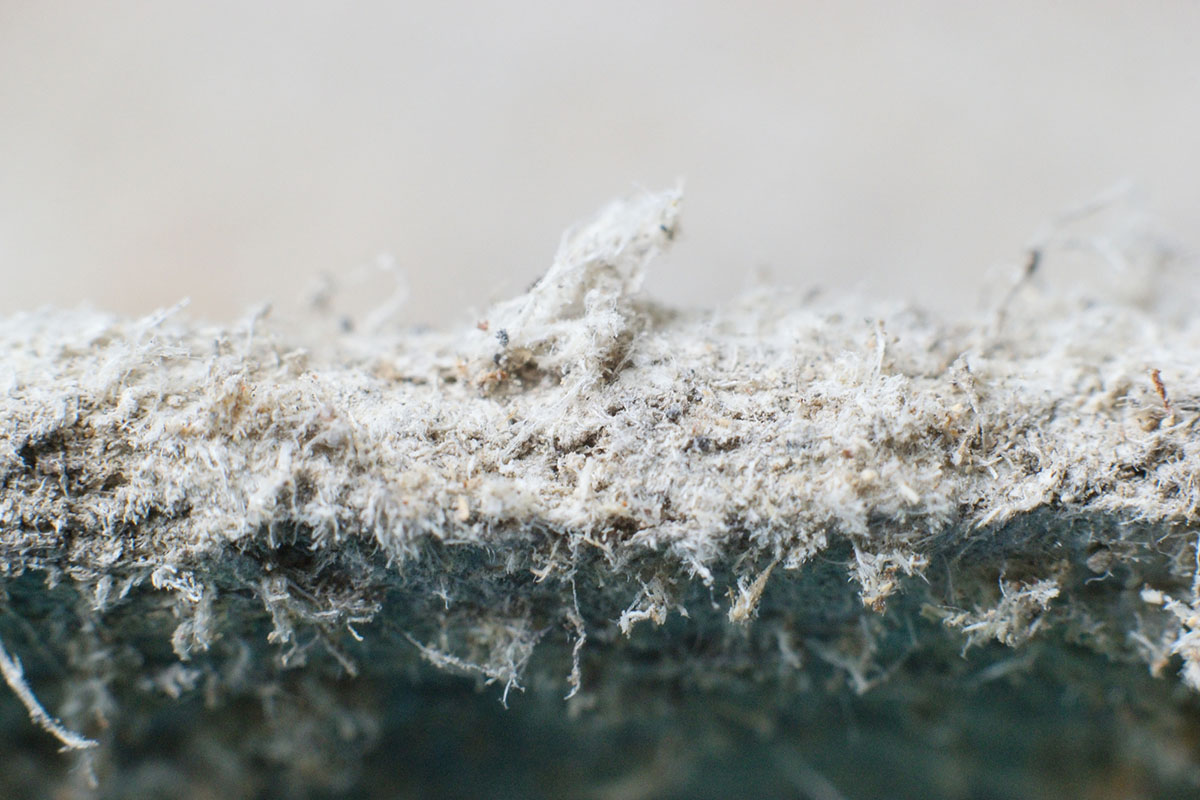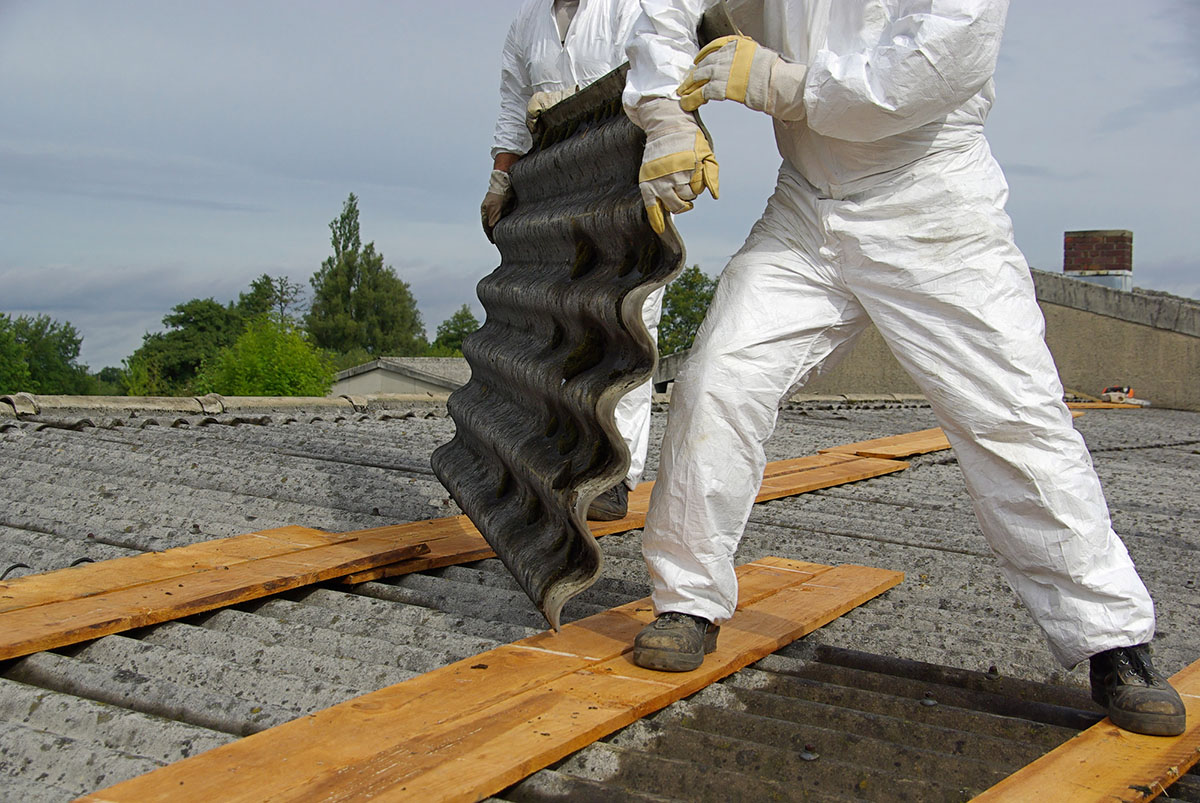

We may earn revenue from the products available on this page and participate in affiliate programs. Learn More ›
Q. I am a homeowner, and I found some strange white fibers in the walls during a renovation. Is it asbestos? What does asbestos look like?
A: Asbestos has long had a reputation as a highly toxic substance that lingers in older homes and buildings. But what is asbestos? Asbestos is a group of naturally occurring minerals that are resistant to heat, fire, and electricity. Because of their durability, they were once widely used in consumer products, from oven mitts to building insulation. However, in the 1970s, it was discovered that exposure to asbestos can cause serious cancers and other diseases such as mesothelioma and asbestosis.
While asbestos is now heavily regulated in the U.S., it’s still possible to find asbestos in older homes and buildings. There are three types of asbestos that are commonly found in residential or commercial properties: crocidolite, amosite, and chrysotile. Homeowners with properties built decades ago may be wondering, what does asbestos look like? Or in this case specifically, what does asbestos insulation look like? In short, it is blue, brown, or white in color, and it often crumbles readily.
It’s important to understand how to identify asbestos and what to do if it is discovered in a home. Here’s what homeowners need to know.
Chrysotile asbestos is white in color and has a layered structure and curly fibers.

The vast majority of asbestos in buildings is chrysotile. This kind of asbestos is commonly found in roofs, ceilings, and walls of buildings. Much of the asbestos found in floor tiles is also chrysotile. It has also been used in car parts such as brake linings, gaskets and boiler seals, and as insulation for pipes, ducts, and appliances. There are two main families of asbestos: serpentine and amphibole. Chrysotile falls under the category of serpentine asbestos, which is characterized by a curly, layered structure. Its flexible but durable properties are some of the reasons for chrysotile’s popularity, as well as the fact that it is naturally resistant to heat and fire.
Amosite asbestos is brown in color and has a higher risk of causing cancer than chrysotile.
Amosite is the second most commonly used asbestos in the U.S. and poses a greater risk of cancer than chrysotile. Brown in color, this form of asbestos was frequently used in cement sheets and pipe insulation, as well as insulation boards, ceiling tiles, and thermal insulation products. It is an amphibole asbestos, meaning it is composed of delicate, needle-like strands that can easily become airborne when touched. While it only accounts for about 5 percent of asbestos in buildings, amosite is considered to be one of the most hazardous varieties.
Crocidolite asbestos is blue in color and has thin fibers that can lodge in lung tissue.
According to Penn Medicine, crocidolite is the most hazardous of all types of asbestos. Like amosite, it is an amphibole asbestos. Because it is extremely fine, its tiny blue fibers are particularly easy to inhale. Fortunately, it is relatively uncommon compared with other asbestos types because it is less heat-resistant. When it was used, it was commonly found in battery casings, spray-on coatings, roof tiles, pipe insulation, plastics, and cement products. Its fibers can be identified by their blue color.
Other types of asbestos include anthophyllite, tremolite, and actinolite, though their use in manufacturing was rare.
Anthophyllite, tremolite, and actinolite are all amphibole varieties of asbestos with a sharp, straight shape. These have been found as contaminants in insulation and other building materials. Trace amounts of tremolite in particular have also been found in cosmetic products. On the whole, these types of asbestos are relatively rare and are considered noncommercial.
Asbestos is commonly found in insulation, floor tiles, textured walls and ceilings, and siding that was installed prior to 1989.
Before it was discovered that asbestos can be hazardous and potentially fatal when inhaled, it was commonly used in construction materials. So where is asbestos found? As a result of its durability and resistance to heat, it has been used in flooring, insulation, ceiling tiles, siding, cement sheets, roofing, and textured ceiling coatings. In 1989, the Environmental Protection Agency (EPA) placed a partial ban on the use of asbestos in building materials. For this reason, it’s most common to find asbestos in houses built prior or 1989. According to Jordan Thomas, a senior environmental consultant at Indoor Science, “Generally any home built before the 1980s may have at least one asbestos-containing material. While rare, it is still possible to find asbestos-containing materials in newer buildings.” Although there are some ways to identify asbestos in the home, it’s generally a good idea to have a professional complete any testing and take care of the removal if asbestos is positively identified.
Friable asbestos crumbles easily and falls apart under slight pressure.
When identifying asbestos, it’s possible to evaluate how easily it crumbles to determine whether it is friable or non-friable. Friable asbestos-containing materials (ACMs), which crumble more easily than non-friable types, are now regulated due to their release of asbestos and associated risks. However, they can still be found today, as they were regularly added to materials prior to regulation.
Friable asbestos is often found in products like thermal insulation for pipes, insulation for water heaters, joint compounds, ceiling tiles, plasters, and wallboards. Since they can be crumbled, pulverized, or reduced to powder by hand pressure, they pose a great risk to those exposed.
It’s also important to note that non-friable ACMs can become friable if broken down or subjected to certain conditions.
Non-friable asbestos does not crumble easily as a friable type does.
Non-friable ACMs, as opposed to a friable type, are quite difficult to crumble. It’s important to note these differences, as non-friable ACMs are still commonly found in production. For example, asbestos tiles and asbestos siding are usually non-friable. For those wondering, “What does asbestos tile look like?” asbestos floor tiles commonly have an oily appearance and are typically adhered to the ground with a thick black material called black mastic.
Because non-friable ACMs have a bonding agent that contains asbestos, there is a much lower risk of releasing these toxic minerals and posing a danger to humans. However, they still remain a threat—especially if they end up getting crushed or broken, such as during a remodeling project.
Asbestos fibers are light and small, so they can float in the air for days.
While asbestos has some distinguishable features, an analysis of its appearance often requires the help of a microscope, which can show its color and shape. This is because asbestos can break down into such small particles that its fibers can’t be seen by the naked eye. Asbestos is only visible if it is in groups or clumps; otherwise, the individual fibers are too small to see without a microscope.
Because asbestos fibers are often microscopic, they can be airborne for days without being detected. This means they are easily inhaled into a person’s lungs, causing serious health issues. Any asbestos exposure is dangerous, but according to the Minnesota Department of Health, the amount of asbestos in the air and the duration of exposure time can affect the likelihood of health issues developing. If homeowners are feeling asbestos symptoms such as chest pain or shortness of breath, they will want to consult with a doctor as soon as possible.

As a raw fiber mineral, asbestos is usually soft to the touch, unless it has been used in making a compound material.
Asbestos, in its raw form, is typically a soft mineral. Chrysotile in particular, which accounted for about 98 percent of worldwide asbestos production in 1988, is made up of soft, flexible fibers. For this reason, it has been used in textiles and even clothing. Chrysotile minerals tend to do less damage to body tissue than other types of asbestos; however, they’re still extremely dangerous and it is recommended that they be avoided.
Testing for asbestos is a job best left to professionals.
Apart from finding visual evidence of asbestos, there are several cases in which asbestos testing may be necessary. “Reasons for asbestos sampling are usually triggered by home renovations, damaged building materials due to flooding or disasters, and during a real estate transaction,” says Thomas. While the potential presence of this hazardous substance can be alarming, there are steps homeowners can take to ensure safety and minimize asbestos exposure. If a homeowner suspects the presence of asbestos in insulation, popcorn ceilings, or other common locations, they’ll want to call a professional for asbestos testing immediately. There are plenty of DIY asbestos test kits on the market, but it’s a good idea to have a professional make this evaluation as they know how to test for asbestos without releasing the fibers into the air. Once the areas of concern are thoroughly evaluated, they’ll recommend an action plan to either remove or repair the asbestos.
A professional can also advise on the best path forward to repair or remove asbestos from the home.
Asbestos repair is typically the preferred method for handling asbestos since it involves the least amount of risk. According to Thomas, “Asbestos-containing materials pose minimal health risk if the material is intact and not disturbed.” A professional can conduct a repair either through encapsulation (coating with a sealant to prevent fibers from becoming airborne) or enclosure (covering with airtight material to prevent the release of fibers). For example, a common way to deal with popcorn ceiling asbestos is to coat it with sealant since removal would require breaking up the material, potentially releasing fibers into the air.
Asbestos removal is considered a last resort for most homeowners who find asbestos. The process of removing asbestos often causes fibers to become airborne within the home, which can pose serious health risks. However, the best asbestos removal companies follow strict guidelines to ensure the safe removal of asbestos, including sealing off the area before disposing of it in a sealed dumpster or at an approved site.
Throughout the process, professionals wear gear and respirators that are specially designed to protect against tiny asbestos fibers. Additionally, these authorized individuals will handle cleanup and re-evaluate the space before homeowners return. Professional asbestos removal costs about $1,123 to $2,872.
While asbestos abatement costs are not insignificant, it’s important to note that DIY removal can be extremely dangerous, and there may even be legal requirements for how asbestos is disposed of depending on the state. Homeowners who discover asbestos in their homes will want to consult a licensed asbestos abatement professional to address the issue. However, knowing how to visually identify asbestos is a good first step in making a home safer to live in.
Sources: Madehow.com
